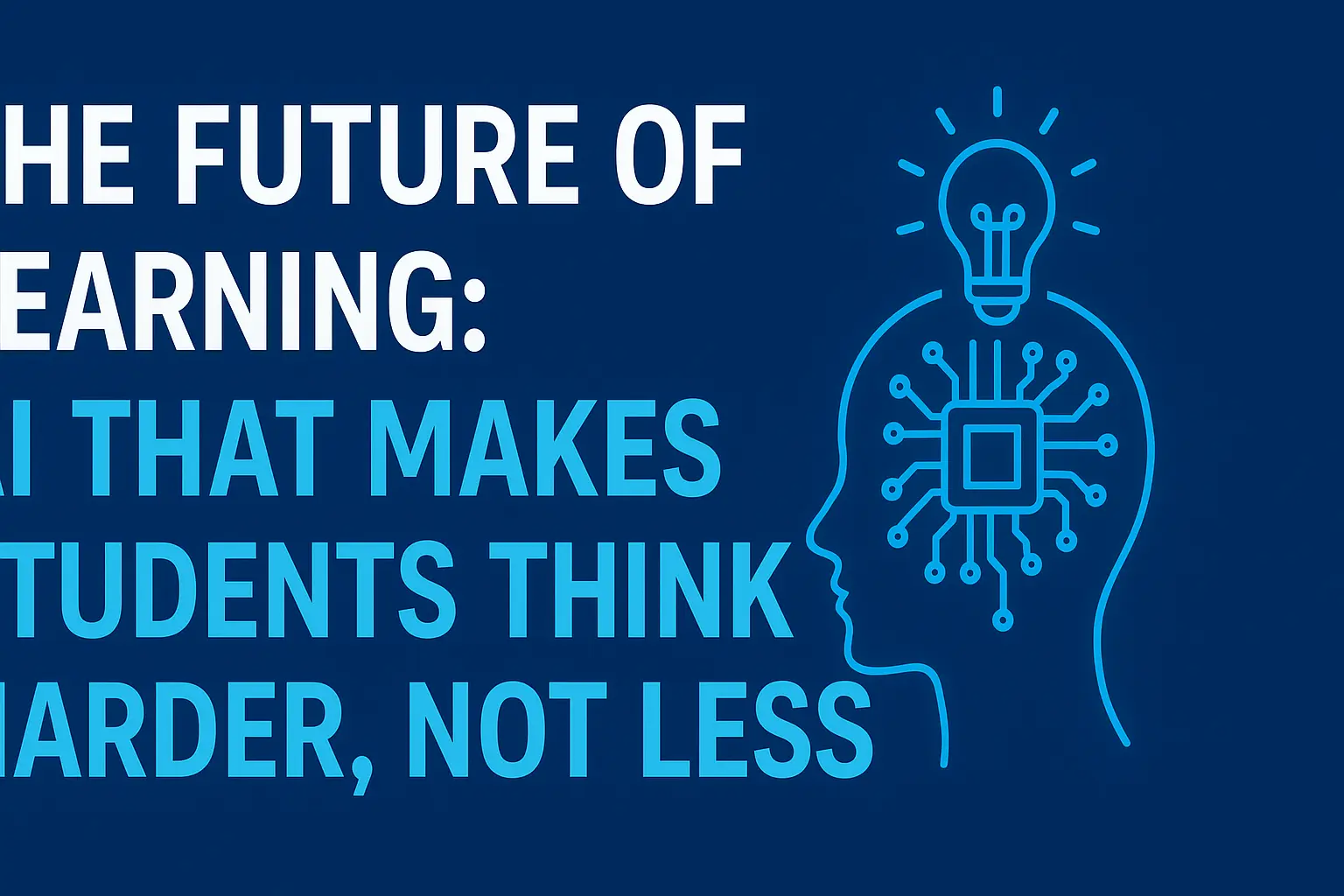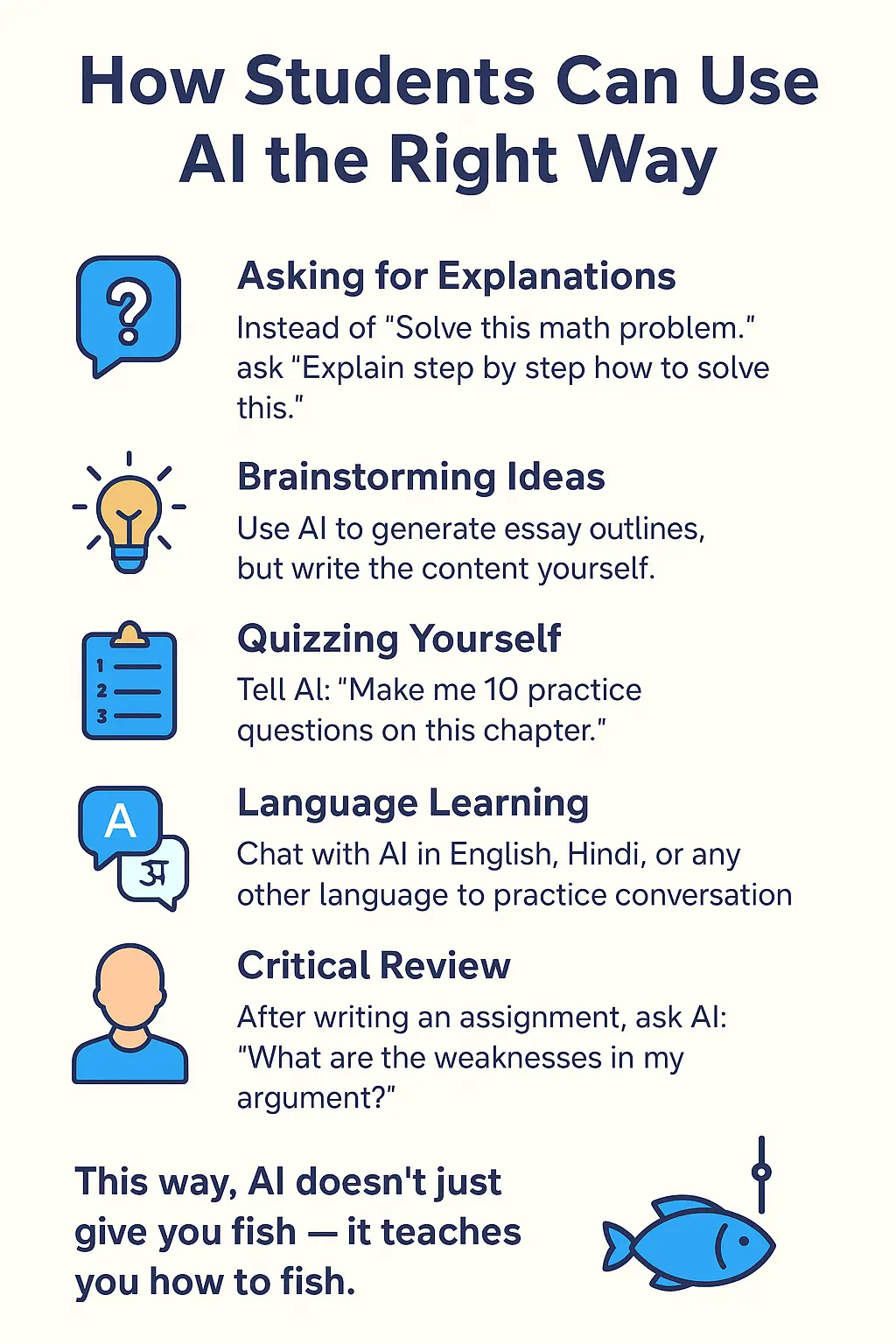✨ The Classroom is Changing
The Future of Learning With AI: A decade ago, learning meant textbooks, chalkboards, and handwritten notes. Today, a student only needs a smartphone or laptop, and they have access to tools like ChatGPT, Gemini, Claude, and AI-powered study apps.
This sounds like a dream, right? But here’s the challenge:
👉 If AI gives all the answers, are students really learning?
👉 If homework is just copy-paste, how will young minds build critical thinking?
The future of learning isn’t about AI doing everything for us. Instead, it’s about AI becoming a thinking partner — guiding, questioning, and pushing students to think harder, not less.

🤔 The Double-Edged Sword of AI in Education
AI is powerful, but like every tool, it depends on how you use it.
🔹 Misuse:
- A student copies an essay written entirely by AI.
- The homework looks perfect but the student doesn’t understand the topic.
- In exams, without AI, they feel lost.
🔹 Wise Use:
- A student drafts their essay, then asks AI to suggest improvements.
- AI asks questions: “Why do you think this argument is strong?” or “What evidence can you add here?”
- The student refines their work and actually learns more in the process.
👉 The difference is simple: one uses AI as a shortcut, the other as a mentor.
📊 Research: What Experts Are Discovering
Several studies have already explored how AI impacts student learning:
- 📉 Less brain activity with shortcuts: Students who let AI do the work showed lower memory and focus levels. (MIT Study, 2024)
- 🧠 Better thinking with guided use: Students who brainstormed before using AI actually performed better in tests, as AI helped refine their thinking instead of replacing it.
- ⚠️ Cognitive offloading risk: Relying too much on AI can make students “mentally lazy,” just like overusing GPS makes us worse at remembering routes.
- 🌟 AI as a coach: Tools designed with Socratic questioning (asking “why” and “how”) boosted critical thinking skills.
🧑🏫 Teachers Are Adapting
Across schools and colleges, teachers are rethinking their methods:
- OpenAI’s Study Mode encourages “productive struggle” — giving hints, not answers.
- Universities like IIT Delhi are drafting AI-use guidelines: students can use it, but they must disclose how.
- Anthropic’s Claude AI is testing “Socratic Mode,” where instead of spoon-feeding answers, it asks back: “What do you think the solution could be?”
- Many educators are also redesigning assignments so students have to show the process, not just the final answer.
This shift ensures AI doesn’t replace teachers — instead, it becomes a co-teacher.
👩🎓 How Students Can Use AI the Right Way

Here are practical ways students can use AI to think harder, not less:
- Asking for Explanations – Instead of “Solve this math problem,” ask “Explain step by step how to solve this.”
- Brainstorming Ideas – Use AI to generate essay outlines, but write the content yourself.
- Quizzing Yourself – Tell AI: “Make me 10 practice questions on this chapter.”
- Language Learning – Chat with AI in English, Hindi, or any other language to practice conversation.
- Critical Review – After writing an assignment, ask AI: “What are the weaknesses in my argument?”
This way, AI doesn’t just give you fish — it teaches you how to fish. 🐟🎣
🧩 The Parent’s Perspective
Parents often worry: “If AI does everything, will my child stop thinking?”
The truth is, kids already use calculators, YouTube, and Google. Did it kill learning? No. It changed learning. Similarly, AI can accelerate curiosity — but only if guided well.
👉 A child asking AI about “How volcanoes erupt” and then building a small science model at home is learning deeply.
👉 A child copying AI’s project report without even reading it is not learning at all.
Parents play a big role here: encourage children to ask questions, not just copy answers.
Read more:
🌍 The Bigger Picture – Future Jobs
Why does all this matter? Because the future of jobs is changing.
- Routine tasks will be automated by AI.
- Creative thinking, problem-solving, and emotional intelligence will matter more than ever.
- Students who only depend on AI may fall behind.
- Students who learn to think critically with AI as a partner will become future leaders.
As one expert said: “AI won’t replace you. But a person using AI better than you, will.”
🏁 Final Thoughts – Smarter Students, Stronger Future
The future of education is not about banning AI, nor about giving it total control. It’s about balance.
AI should not be a shortcut to avoid thinking. Instead, it should be a bridge to deeper thinking.
At BharatSchemes.com, we believe:
- Students should use AI as a study buddy, not a homework machine.
- Teachers should guide students to use AI for exploration, not exploitation.
- Parents should encourage curiosity, not copying.
The classroom of the future will not be about memorizing and repeating. It will be about curiosity, creativity, and critical thinking — with AI as the assistant, not the master.